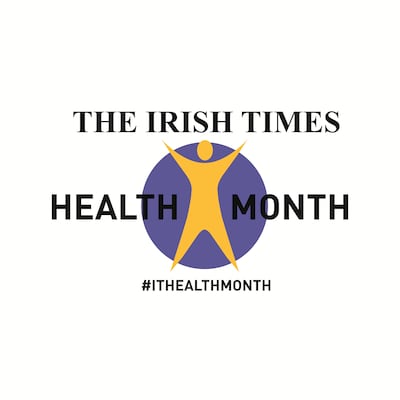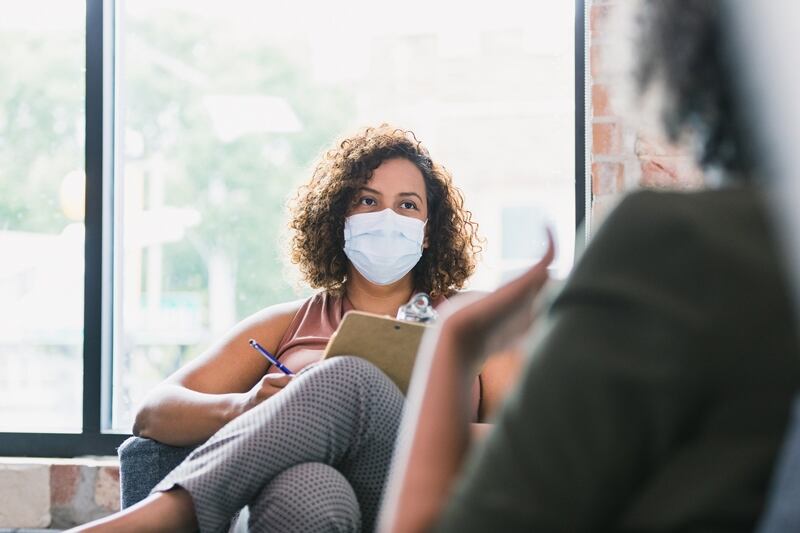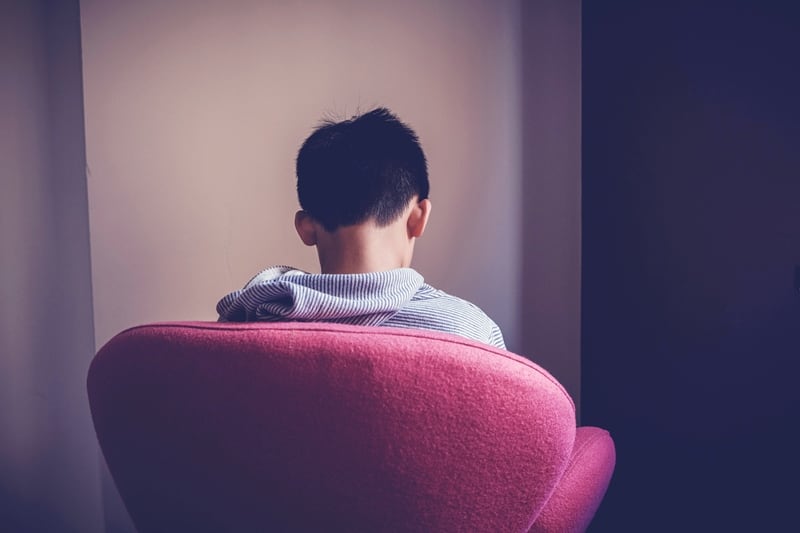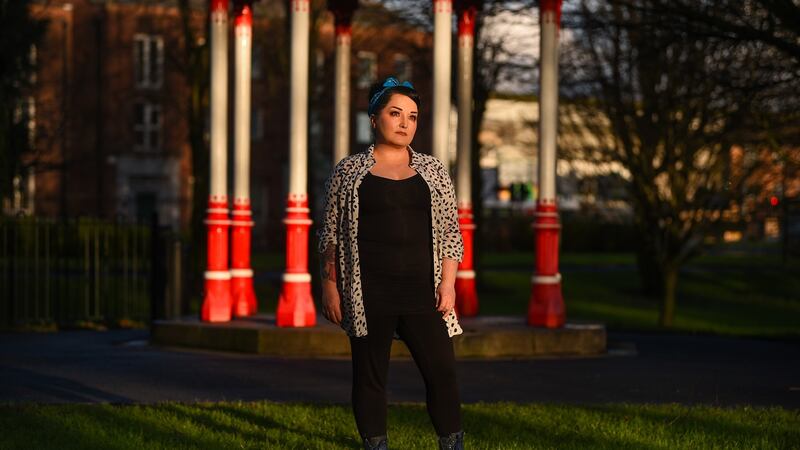Covid-19 has shown up huge deficits in our health system, and it’s about to do the same to our mental health system. Last year a report from HSE specialists spoke of the increased demand for mental health services and warned that a “tsunami of mental health need will arise sometime after the initial pandemic peak, will persist for months to years afterwards and will be compounded by the economic impact of the pandemic”.
“We’re anticipating this,” says one of the report’s co-authors, Dr Karen O’Connor, a psychiatrist and the national clinical lead for early intervention in psychosis. “I don’t want to overstate it, but it’s based on the numbers that we’re getting out of our early intervention and psychosocial services.”

Winter Nights
The mental health system as it stands isn’t resourced to deal with a crisis, largely because it’s already in one. There are 2,000 children and young people waiting for Child and Adolescent Mental Health Services (CAHMS) in Ireland, and 10,000 people waiting for primary care psychology, the majority of whom are also children.
“This means a GP felt [the person] needed to speak to a psychologist,” says Ray Burke, senior communications and advocacy officer with Mental Health Reform. “And then they just went on to this massive waiting list. A huge concern across the sector is that, while they’re waiting, things get worse.”
"My main takeaway from the system is that once you're relatively stable, they don't care about helping you get better"
In response to a recent query on social media, I received more than 60 messages from people who told me about their experiences or those of close relatives while navigating the public mental healthcare system. Many spoke of meeting kind mental-health professionals who helped them, but most also described system failures that left them feeling distressed and alone and, often, not sick enough to deserve help.
They wrote about being on waiting lists for mental health services and overworked staff who treated them like they were filling in a “checklist”. Overall, they described a system that often waits until a mental-health issue becomes a mental health emergency before engaging fully.
Here are just four of the responses:
1 "I was referred to the hospital . . . I was self-harming and my doctor was afraid I would take my own life. The staff there said my case wasn't severe enough for them to help me, and they sent me home with advice to go to Pieta House or the university's counselling services."
2 "I think the system of rotating doctors is completely incompatible with mental-health services. To begin the process of opening up with a new point of contact every six months is lunacy . . . And you are unfortunately very reliant on personalities . . . Do you gel with your assigned psychiatrist? . . . Are you high-priority or is your misery less severe?"
3 "I was convinced I was starting to have a psychotic episode and I did everything they tell you . . . [I contacted the HSE funded text service] 50808 who told me to contact the Caredoc or 999 . . . I called 999 who told me to come into the hospital where my usual psychiatrist was on call. She proceeded to tell me I need to learn coping mechanisms … and that they couldn't do anything because I'm not suicidal and sent me home. Since then I've had nurses calling and doing the checklist shit with me every day or so, but they don't seem to have any plan to stop me feeling this way."
4 "My main takeaway from the system is that once you're relatively stable, they don't care about helping you get better."
"We're not short on good ideas . . . The problem is that they aren't implemented properly
We often assume when discussing system failures that the solution lies in new ideas. But the consensus from the mental health professionals and advocates I spoke to for this article is that we have all the good ideas we could ever need in mental health plans like Planning for the Future (1984), A Vision for Change (2006) and Sharing the Vision (2020).
This last report aspires to a community-based “recovery” model in which there are clearly defined “stepped care” pathways: from social and family supports; to primary care; to well-staffed specialist mental health services in the community; to specialist residential services.
It promotes early intervention, the involvement of service users and family members in planning their own care and takes account of societal issues like prejudice, inadequate housing and under-employment. Innovations, like online psychological services, crisis cafes (where people can go instead of A&E during a mental health emergency) and recovery colleges (to educate and empower people around their mental health problems), are all recommended.
Possibly in response to criticism of how previous policies were implemented, it promotes the establishment of a “national implementation and monitoring committee”.
Like A Vision for Change this new document is widely welcomed but also greeted with some trepidation by mental health experts.
“We’re not short on good ideas,” says Burke. “The problem is that they aren’t implemented properly . . . So even though our new policy Sharing the Vision looks really good, how do we achieve this new vision if we haven’t even finished the old vision? In 2019 the HSE said that it needed €189 million to fully implement the staffing requirements that were set out In A Vision for Change.”
Ireland only spends 6 per cent of its overall health budget on mental health. Consequently, according to Burke, local mental-health services have around 60 per cent of the staffing recommended in A Vision for Change (in some areas, he believes this is at less than 50 per cent).
A Vision for Change recommended that 8 per cent of the overall health budget should go to mental health. “In the UK they’re at 12 per cent,” says Dr Karen O’Connor. “In Germany it’s 12 per cent. Scandinavian countries spend between 10 per cent and 12 per cent. We don’t spend enough on mental health. We develop really good plans, but then we don’t resource them to the level that we need to. That just increases frustration. People know what it should look like, but they can’t achieve it.”

Slowly, since the 1980s, the mental-health system has been moving from the dark institutional approach where people were, in Burke’s words, “hidden away” to something more community-based.
Michael Ryan, the HSE’s national head of mental health and recovery, is the lead author of the Framework for Recovery on Mental Health and a passionate proponent of the person-centred “recovery approach”.
He tells me about the need for a change of culture so that service users are put at the centre of a holistic recovery plan where they feel supported and listened to. However, many of the other people I speak to say the biggest obstacles to this are really a lack of resources.
As the system currently works, GPs refer people when necessary on to psychologists or local mental-health services with many different specialists. John Saunders, chief executive of Shine and chairman of the Mental Health Commission, tells me that in practice GPs are “overwhelmed” and secondary mental health teams are understaffed.
“These should be multidisciplinary teams of doctors, nurses, psychologists, occupational therapists, speech and language therapists, social workers and a few other therapists. But they’re under-resourced . . . So what happens is people don’t get the type of preventative first resort support that they need . . . You’re therefore getting a situation where services of last resort sometimes become services of first resort.
“For example, the emergency crisis admission into a general hospital through accident and emergency. CAMHS are under particular pressure. [Sometimes] clinicians are forced to choose between not doing anything or placing a child into an adult service.”
"Had I been seen earlier and had I been afforded the interventions that I needed, I wouldn't have required hospitalisation in the end"
Aoife Ní Bhriain is a psychiatric nurse who works in an acute mental health unit in a public hospital and has also written about her own personal experience of the system.
“[We] threw the baby out with the bathwater,” she says. “We closed units and fostered this recovery in the community and the recovery framework, but we didn’t substitute those beds that we closed with actual supports and hostels and high support hostels. [Now] it is incredibly difficult to get access to acute mental health units . . . The primary issue is that we don’t have the beds and we also don’t have the resources to treat people in the community adequately with the higher level of support that they need.”
Ní Bhriain began to suffer with her own mental health six years ago after a traumatic event (unrelated, she stresses, to her work). “It’s acutely difficult to access services . . . I don’t have private healthcare. There is an employee-assistance programme where they give you counselling, but you only get your six sessions.
“I tried to access local services and, at the time, the psychiatrist that was treating me felt that I needed therapy but there was no psychologist working with the team. So I was given meds and told see him once a month.”
Around three years ago Ní Bhriain became an inpatient at a public hospital (not the one she works in). “There was very little therapy provided on the unit,” she says. “The therapist didn’t turn up on numerous occasions. I received a very standard letter to say this was due to staffing . . . If you are an inpatient, you need therapy. An occupational therapist came down and started talking about doing the couch to 5km and physical exercise. And I was looking at him going, ‘Man, I can’t get it together to tie my shoes’.”
As someone who works in the system she is very aware of the gap between what services aspire to be and how they actually operate. “The recovery framework is basically about choice and about hope and personal autonomy . . . It’s about very short admissions and about people having access to services in the community . . . [But] we don’t have supported housing. We don’t have structured employment opportunities or activities that will support people that may become unwell and relapse but can return to work on a two-day or three-day week . . .
“Instead what we do is create people that bounce in and out of acute services never experiencing long periods of mental health stability in the community . . . I would argue that had I been seen earlier and had I been afforded the interventions that I needed, I wouldn’t have required hospitalisation in the end.”
Within their confines they're tremendously helpful and caring people . . . They know how terrible this is but they have no control over it"
Cliona Murphy has had experiences of the public health services across generations. When she was a child her father suffered from severe mental health problems and, more recently, her 16-year-old son has been coping with depression.
“He became ill last year, and we didn’t really pick up on it initially. He came to us and said, ‘I think I’m depressed’. Then we went to our GP who was brilliant. As for CAMHS? Well you can whistle . . . The waiting list for CAMHS was something like 22 months. So your option then is to bring them to A&E . . . I just couldn’t put that on him.”
Murphy works in the health system and made a number of calls. “I couldn’t get anyone to see or signpost me. [Eventually] I found a private appointment in the North . . . I drove up . . . got an appointment, had a prescription . . . And we then were facilitated to get counselling. We were able to get that privately . . .
“Even privately I couldn’t get an appointment for him in what I thought was a timely manner. I think there’s a thing in this country that people who are mentally disadvantaged, they’re not the people that vote [or] advocate for themselves. There’s still a stigma.”

Carol (not her real name) contacts me to tell me about her nine-year-old son. “We lived in a house with my son’s father for a number of years. He was very mentally unwell and abusive. When we finally got him out of the house, my son was four . . . I found a private play therapist. He saw him for between two and three years.”
More recently her son became fearful of certain noises and sensations. He has shown a reluctance to get dressed or leave the house. For a period he was hitting out and sometimes injuring himself. She believes, from her own research, that his symptoms could either be a sign of autism or a response to trauma.
But she also knows that she’s not an expert and has been waiting for psychological services since late in 2019. “We’d been told we had an entitlement to be seen within a specific timeframe but they also said the likelihood was that we wouldn’t be seen in that timeframe.”
The staff she has spoken to are very apologetic, she says, and they recognise the seriousness of the situation. Towards the end of last year, virtual counselling was made available but it was decided that wouldn’t work for a child so young.
“They do know what should be happening and they’re well trained . . . Within their confines they’re tremendously helpful and caring people, but there’s no resources . . . They know how terrible this is but they have no control over it.”
"Suicide in Ireland is also a pandemic . . . Now they've shown that they can get the resources when they need to"
Jen Ronan is a mental health ambassador for See Change, an organisation that battles mental health stigma. More recently she has been volunteering to help Haven Hub, a group that patrol Limerick’s rivers at night looking for people who might be suicidal.
“I live near the river. When you hear the helicopter you know that they’re out there because someone has gone in . . . A young rap group in Limerick called it ‘the iron banshee’ . . . It’s almost part of Limerick’s identity now.”
Ronan has had issues with mental health since she was a child but it was only in 2013 after her mother died that she encountered the public system. She felt suicidal. Her friend brought her to A&E.
“I was obviously very depressed, but I was sitting in A&E thinking about ending things but also thinking ‘I don’t have a broken arm’. They had a crisis nurse . . . It felt like almost automatic responses he was giving . . . ‘Ah, sure, you’re a great girl’ and ‘Sure, you’ve everything to live for’ . . . He didn’t seem all that engaged.
“I’m fairly together and well-spoken. I don’t present as somebody who is massively in crisis but you need a professional to kind of see through that . . . But I got a referral from him for my doctor. And then I got a referral from there to a day psychiatric clinic.”

It was two months before she was seen. “It was like ‘Don’t kill yourself between now and then.’ . . . At the time when I got in for my first referral, I was not good at all. I could barely function. I didn’t open letters. I stayed in bed. I didn’t wash myself . . . I was just surviving . . .
“What we would love in an ideal world – in mental-health advocacy – is a mental-health A&E, a separate one where you could go if you’re in crisis.”
The day clinic was very under-resourced, she says, with the consultant psychiatrist stretched between the clinic and the regional hospital. There was also a lack of continuity of staff.
She talks about how difficult it is to have to recount your life story to people again and again. She laughs about a time she told a new doctor how upset she was by the suicide of Robin Williams. “The doctor said: ‘And did you know this Robin Williams well?’ And I said, ‘No, he’s an actor. And now I feel even more stupid’.”
But some elements of the system, she says, worked quite well for her. She had a good experience with her therapist (“It’s almost like Tinder when you get a therapist through the public system; you have to hope you gel”) and in some ways the pandemic response has made her hopeful.
“Suicide in Ireland is also a pandemic . . . Now they’ve shown that they can get the resources when they need to.”
"At the start I couldn't even talk properly and I was very lost. It's just been a year of working on myself . . . I honestly don't think I could have done without RISE."
Everyone I speak to shares a discomfort with the public discourse on mental health. The consensus is that it’s too narrowly-focused on milder forms of depression and anxiety and self-management techniques like mindfulness and exercise.
“That’s not the entire scope of mental ill-health,” says Sinead Keating, a See Change ambassador with a diagnosis of bipolar disorder type 2. “So we slip into the notion that we’re very good at talking about mental health, when instead we’re really boxed in.”
Dr Karen O’Connor thinks that many people believe “it’s all about prevention. There’s no evidence that if you walk every day and you do mindfulness, that you’ll prevent yourself from developing a psychotic illness . . . So the young people that I see, they would blame themselves or feel that other people are blaming them.”
Why does she think there’s resistance to widening the discussion? “There’s a sense sometimes that if we put all the focus on awareness, well then we don’t have to invest in the mental health services,” she says. “I went and worked in Australia in mental health in 2008-2009 and I feel like we’re kind of where they were then. In Australia, they transitioned on from talking and awareness campaigns into funding new services.”
John Saunders believes that there’s a cultural pessimism in this country about more serious forms of mental illness based on the terrible ways in which people were treated in the past.
“There’s a sense from our inheritance that people don’t make a recovery which is completely untrue. People make significant recoveries with the right resources.”
Experiences differ hugely based simply on location. Dr Karen O’Connor puts me in touch with 23-year-old Richard, who has been accessing the specialised RISE (Responsive Early Intervention for Psychosis Service) she runs in Cork for people with psychosis.

Richard first experienced an episode of psychosis in September of 2019 on his birthday. He had been repeating a college course, while working to pay his rent, and the stress of it all became too much. “The best way to explain it is kind of exaggerated beliefs,” he says. “You completely lose track yourself and reality, and you kind of go into a kind of dream land.”
His mother, who had been a nurse, noticed what was happening and sought help. He went into the psychiatric ward in Cork for 19 days where he received medication and rest, after which he was referred to RISE. There he has, among other resources, a key worker, a CBT (Cognitive Behavioural Therapy) counsellor, a careers counsellor and a peer support worker who has had personal experience of psychosis. This holistic approach suits him and he feels on the road to recovery.
“At the start I couldn’t even talk properly and I was very lost. It’s just been a year of working on myself . . . I honestly don’t think I could have done without RISE.”
This seems like the person-centred approach the wider system aspires to. In contrast I have spoken with others who never received more than monthly psychiatrist visits and medication from the public system.
O’Connor and her colleagues are worried about the effect the pandemic is about to have on this already stretched system but doesn’t think we really need new ideas to deal with the crisis.
“We just need to properly resource the system we have,” she says. “Healthcare, and particularly mental healthcare, is a face-to-face thing. And if you don’t have the people to match up to the people who need the care, well, then you can’t do it. It isn’t a mystery.”
If you are affected by issues in this article you can call Pieta House 1800 247247 or text “HELP” to 51444, Contact Aware at 1800 80 4848 or supportmail@aware.ie or the Samaritans at 116123 or jo@samaritans.ie. You can also text “HELLO” to 50808

















